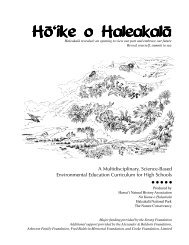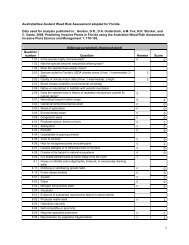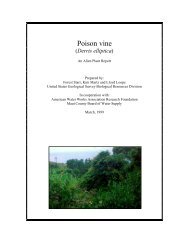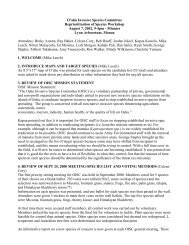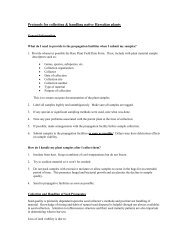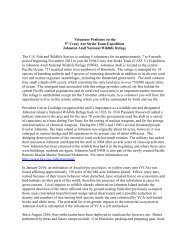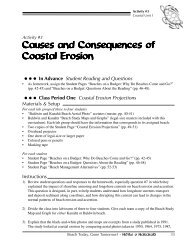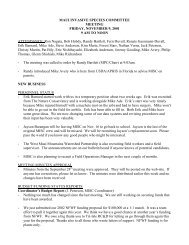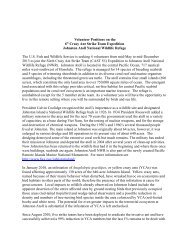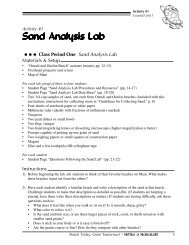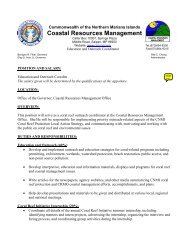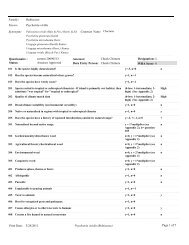Crazy Ant Strike Team Crew Leader
Crazy Ant Strike Team Crew Leader
Crazy Ant Strike Team Crew Leader
Create successful ePaper yourself
Turn your PDF publications into a flip-book with our unique Google optimized e-Paper software.
<strong>Crazy</strong> <strong>Ant</strong> <strong>Strike</strong> <strong>Team</strong> <strong>Crew</strong> <strong>Leader</strong><br />
The US Fish and Wildlife Service (USFWS) and the Research Corporation of the<br />
University of Hawaii are now accepting applications for the crew leader of The Fifth <strong>Crazy</strong> <strong>Ant</strong><br />
<strong>Strike</strong> <strong>Team</strong> (CAST V) Expedition to Johnston Atoll National Wildlife Refuge (NWR). Johnston<br />
Atoll NWR is located in the central Pacific Ocean, 717 nautical miles west-southwest of<br />
Honolulu. The refuge is managed for 14 species of breeding seabirds and 5 species of wintering<br />
shorebirds in addition to its diverse coral reef and marine organism assemblages, including the<br />
threatened green turtle. The atoll comprises four small islands (696 acres), which constitute the<br />
only land area in over 750,000 square miles of ocean. The emergent land associated with this<br />
refuge provides critical, rat-free habitat for central Pacific seabird populations and its coral reef<br />
ecosystem is an important marine resource. The refuge is uninhabited except for the 5 members<br />
of the strike team.<br />
In January 2010, an infestation of Anoplolepis gracilipes, or yellow crazy ants (YCAs) was<br />
found affecting approximately 130 acres of the 640-acre Johnston Island. Yellow crazy ants,<br />
named because of their manic behavior when disturbed, have wreaked havoc on ecosystems and<br />
bird habitats in other parts of the world; therefore the presence of this infestation is cause for<br />
great concern. Local impacts to wildlife already observed on Johnston Island include the<br />
apparent desertion of the entire affected area by ground nesting birds that previously occupied<br />
those areas (red-tailed tropicbird and wedge-tailed shearwater) and a possible reduction in<br />
density and numbers of tree-nesting bird species inside the area colonized by YCA (red-footed<br />
booby and white tern). The potential for even greater impacts to the terrestrial ecosystem at<br />
Johnston Atoll is substantial if the infestation of YCA is left unchecked.<br />
Candidates for the <strong>Crew</strong> <strong>Leader</strong> position will need to be available in early November to assist<br />
with trip preparation followed by an approximate 7-month deployment to the CAST field camp<br />
starting in early December. The crew leader will be responsible for training and supervising a<br />
crew of 4 volunteers in the performance of management activities, biological monitoring,<br />
research investigations and facility maintenance. The primary goal of the CAST V expedition<br />
will be to continue developing effective eradication techniques of YCA. Responsibilities will<br />
include but are not limited to:<br />
• Fine tune monitoring techniques for presence-absence of YCA.<br />
• Develop, institute, and evaluate biosecurity (quarantine) protocols to prevent the spread<br />
of YCA.<br />
• Eradicate ants using a combination of commercially available formicides in bait stations<br />
and other application methods.<br />
• Evaluate the ecological impacts of YCA within and outside the infested area before and<br />
after ant eradication efforts.<br />
• The submission of weekly Situation Reports to Project Managers<br />
• The creation of a technical report on methods to eradicate yellow crazy ants from island<br />
ecosystems.<br />
• Additional biological monitoring of seabird, shorebird, and sea turtle populations.<br />
The ideal candidate will have experience in remote camping, supervising crews, conducting<br />
biological surveys, application and safe handling techniques of non-restricted pesticides,<br />
maintenance of photovoltaic systems, generators, bicycles, and other camp related equipment.
It is imperative that candidates consider that Johnston is a remote site where all but<br />
emergency access is by ship, which takes 3-5 days to transit from Honolulu. No re-supply or<br />
ship visits during the 7-month camp are anticipated. On the island, transportation will be by<br />
foot or bicycle. Living conditions are primitive consist of 12x14x6 ft personal tents and a bunker<br />
will be used for communal/food storage/kitchen and office. Bathing is done in sea water.<br />
Contact with the island has proven to be reliable but is limited to slow internet access. However,<br />
this internet access cannot be guaranteed and communication could be limited to text only e-mail<br />
with no internet. Direct medical attention is at minimum 1-3 days away. Safety in this remote<br />
setting is of primary concern and all individuals are expected to work together as a team to<br />
maintain good communication at all times.<br />
CAST members will be expected to work at least 48 hours/week, 6 days/week .<br />
However, this does not necessarily mean 8-5 M-F as some projects will necessitate working<br />
evenings or consecutive days. Pay scale is equivalent to a GS-7 position.<br />
Requirements: A BS or higher degree in biological science or natural resource<br />
management related fields. At least 2 years of biological field work experience. Ability to<br />
maintain facilities such as photovoltaic systems, propane appliances, bicycles, Must be able to<br />
walk 10 miles per day, lift 70 lbs, be comfortable with insecticide use, and ride a bicycle. Much<br />
stooping and bending will be required to maintain the bait stations candidates need to be fit and<br />
able to work in hot humid conditions. Weather conditions can be harsh with strong winds, gales,<br />
and hot sun. Since travel to the island is by boat, and at times in high surf conditions, the<br />
possibility of capsize exists. Applicants must be able to swim. All <strong>Strike</strong> <strong>Team</strong> members must<br />
follow all pesticide and safety protocols.<br />
Prior experience in the following is preferred: remote camping experience, invasive species<br />
control, shorebird and seabird identification and monitoring, entomological surveying, familiar<br />
with GIS tools and software, data management, pesticide application, and technical report<br />
writing.<br />
The U.S. Fish and Wildlife Service will provide: housing in Honolulu (pre-deployment staging<br />
and post camp breakdown and debrief), transportation between Honolulu and Johnston, and food<br />
and housing on Johnston.<br />
The position will be open until filled but no applications will be accepted after Sept 21 st . Submit<br />
a cover letter, resume and at least 3 references to both:<br />
Lee_Ann_Woodward@fws.gov<br />
Stefan_Kropidlowski@fws.gov



